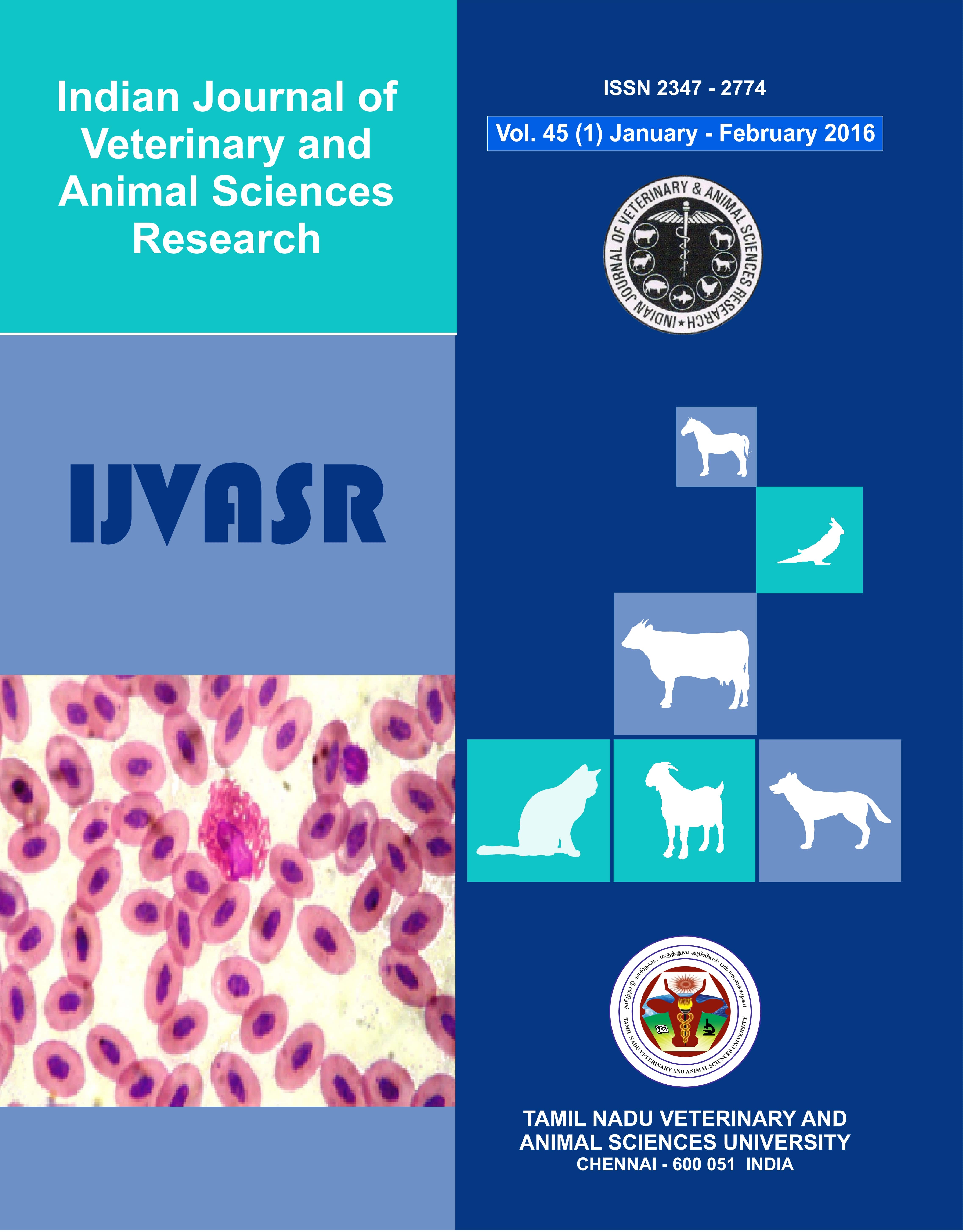Effect of feeding enzyme mixture with Fibrolytic activity in dry and solubulized Forms on the performance of lambs
Keywords:
EFE, Solubility, ADG, FCR, performanceAbstract
One hundred lambs (11.8 kg ± 0.56) divided at random into 4 groups G1, G2, G3 and G4 were supplemented with exogenous fibrolytic enzyme mixture (EFE) in concentrates after 6 hours outside grazing. G1 and G2 were given 200 and 400 g of EFE per 50 kg feed in dry form, G3 and G4 were given EFE in solubulized form at 20 and 40 g per litre of water, respectively. The initial and final weights (kg) were non-significant among treatments. The total weight gain (kg) was higher (P<0.05) for G4 and G2 as compared to other two. Average daily gain (g) was highest (P<0.05) for G4 followed by G2, G1 and G3. Total weight gain (%) is 15, 7.6 and 16.5 lower (P<0.05) for G1, G2 and G3 (Table) as compared to G4. Lowest (P<0.05) FCR was observed for G4 and is in the order of G4< G2< G1< G3. The cost of the feed per kg gain was lower (P<0.05) by 21%, 26% and 13% for G4 as compared to G1, G2 and G3. It can be concluded that addition of EFE in solubulized form was found better for the reason that it forms a stable complex with the feed and thus facilitates for the rumen bacterial attachment earlier for rapid action due to an increase in rumen bacterial population
Downloads
References
Bala, P., Malik, R., and Srinivas, B.(2009). Effect of fortifying concentrate supplement with fibrolytic enzymes on nutrient utilization, milk yield and composition in lactating goats. Journal of Animal Science, 80: 265-272.
Beauchemin, K.A., Colombatto, D., Morgavi, D.P., Yang, W.Z., and Kampen, R. (2004). Mode of action of exogenous cell wall degrading enzymes for ruminants. Canadian Journal of Animal Science, 84: 13-22.
Chakeredza, S., Meulen,U. and Ndlovu, L.R. (2002). Ruminal fermentation kinetics in ewes offered a maize stover basal diet supplemented with cow pea hay, ground nut hay, cotton seed meal or maize meal. Tropical Animal Health Production, 34: 215-230
Colombatto,D., Mould,F.L.,Bhat,M.K., and Owen, E. (2003). Use of fibrolytic enzymes to improve the nutritive value of ruminant diets: A biochemical and in vitro rumen degradation assessment. Animal Feed Science and Technology, 107: 201-209.
Dean, D.B., Adesogan, A.T., Staples, C.R., Kim, S.C. and Little, R. (2006). Effect of adding a fibrolytic enzyme to a dairy cow diet on ruminal fermentation and TMR degradation. Journal of Dairy Science, 89 (Suppl.1) 405 Abstract.
Giraldo, L.A., Tejido, M.L., Ranillo, M.J., Ramos, S. and Carro, M.D. (2008). Influence of direct Fed- fibrolytic exogenous enzymes on diet digestibility and ruminal activity in sheep fed a grass hay-based diet. Journal of Animal Science, 86: 1617-1623.
Kung, L.,Jr., Cohen, M.A., Rode, L.M. and Treacher R.J. (2002). The effect of fibrolytic enzymes sprayed on to forages and fed in a total mixed ration to lactating dairy cows. Journal of Dairy Science, 85: 2396-2402.
Mc Allister, T.A., Hristov, A.N. Beauchemin, K.A., Rode, L.M., and Cheng, K.J. (2001). Enzymes in ruminant diets. In: Enzymes in farm animal Nutrition. Eds. Bedford, M .R. & Patridge, G.G., CAB Inter.pp 273-298.
Morgavi, D.P., Beauchemin, K.A.,Nsereko ,V.L., Rode, L.M., Iwassa, A.D., Yang, W.Z., Mc Allister, T.A., and Yang, W.(2000 a). Synergy between ruminal fibrolytic enzymesand the enzymes from Trichoderma longibrachiatum. Journal of Dairy Science, 83: 1310-1321.
Morgavi, D.P., Newbold, C. J., Beever, D.E., and Wallace, R.J., (2000 b). Stability and stabilization of potential feed additive enzymes in rumen fluid. Enzyme microbiology and Technology, 26: 171-177.
Nsereko, V.L., Beauchemin, K.A., Morgavi, D.P., Rode, L.M., Furtado, A.F., Mc Allister, T.A.,Iwaasa, E.A., Yang, W.Z. and Yang, Y. (2002). Effect of fibrolytic enzyme preparation from Trichoderma longibrachiatum on rumen population of dairy cows. Canadian Journal of Microbiology, 48: 14-20.
Pinor-Rodriguez, J.M.,Gonzalez, S.S., Mendoza, G.D., Barcena,R., Cobos, M.A., Hernandez, A. and Ortega , M.E., (2002). Effect of exogenous fibrolytic enzyme on ruminal fermentation and digestibility of alfalfa and rye- grass hay fed to lambs. Journal of Animal Science, 80: 3016-3020.
Reddish, M. A. and Kung Jr. L. (2007). The effect of feeding a dry enzyme mixture with fibrolytic activity on the performance of lactating cows and digestibility of a diet for sheep. Journal of Dairy Science, 90: 4724- 4729.
Rode, L.M., Yang,W.Z., and Beauchemin, K.A., (1999). Fibrolytic enzyme supplements for dairy cows in early lactation. Journal of Dairy Science, 82: 2121-2126.
Snedecor, G. W. and Cochran, W G. (1989). Statistical methods (8 th Ed.). Iowa State University Press, Ames, Iowa, USA.
Van Soest, P.J. (1994). Nutritional Ecology of the ruminants. 2nd Edition. Cornell University Press, Ithaca, NY, USA.
Yang, W.Z., Beauchemin, K.A. and Rode, L.M. (1999). Effect of an enzyme feed additive on extent of digestion and milk production of lactating dairy cows. Journal of Dairy Science, 82: 391- 403.
Downloads
Submitted
Published
Issue
Section
License
All the copy right belongs to the sponsoring Organization, Tamil Nadu Veterinary and Animal Sciences University, Chennai - 51.

